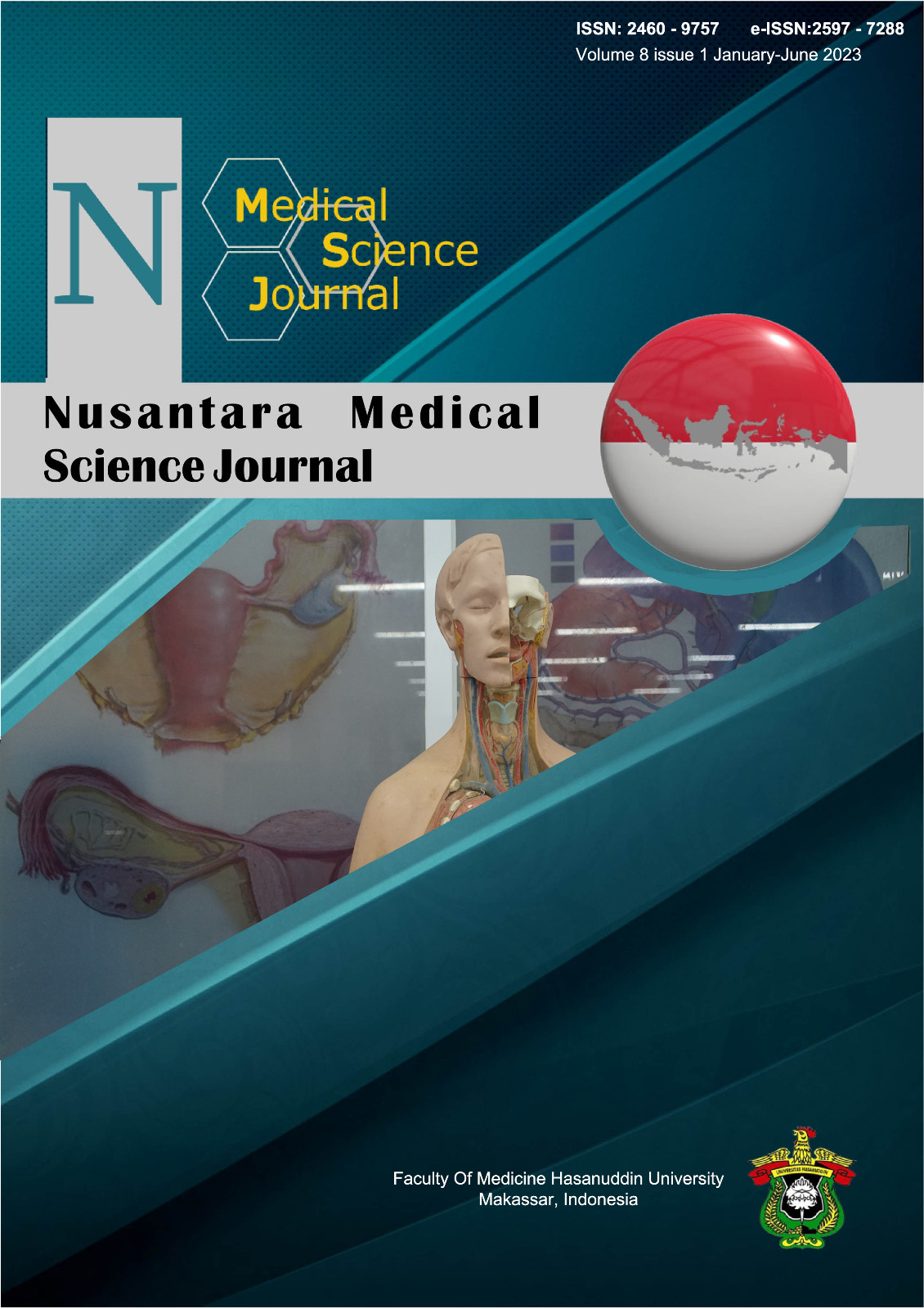Effectivity of Repetitive Transcranial Magnetic Stimulation Improving Depressive Symptoms and Motoric Strength Ischemic Stroke
DOI:
https://doi.org/10.20956/nmsj.v8i1.26490Abstract
Introduction: Post-stroke depression often causes problems. Depression can slow motor recovery. Giving antidepressants takes one month, and thus Transcranial Magnetic Stimulation (TMS) was developed, especially repetitive Transcranial Magnetic Stimulation (rTMS). This study aims to assess the effectiveness of rTMS in improving depressive symptoms and motor strength in ischemic stroke patients. Methods: An experimental study with a randomized pretest-posttest control group design was conducted at Wahidin Sudirohusodo Hospital and a network hospital in Makassar from August to October 2022. The treatment group received standard therapy for ischemic stroke, antidepressants, and rTMS; the control group received standard therapy for ischemic stroke and antidepressants for ten days. In this study, the Hamilton Depression Rating Scale (HDRS) and the Medical Research Council (MRC) scale were used and measured in the treatment and control groups on the first and tenth days.
Results: A total of 40 subjects met the criteria and were divided into a treatment group (n = 20) and a control group (n = 20). The HDRS score in the treatment group was smaller than in the control group. The value of left extremity motor strength in the treatment group was greater than that of the control group using the Wilcoxon Test. The correlation of the HDRS score to motor strength in the treatment and control groups showed a negative correlation of the HDRS score to the left extremity using the Spearman Test.
Conclusions: rTMS effectively improves depressive symptoms and motor strength in ischemic stroke, given standard ischemic stroke therapy, antidepressants, and rTMS.
References
Benjamin EJ, Muntner P, Alonso A, Bittencourt MS, Callaway CW, Carson AP, et al. Heart Disease and Stroke Statistics-2019 Update: A Report From the American Heart Association. Vol. 139, Circulation. 2019. 56–528 p.
Venketasubramanian N, Yoon BW, Pandian J, Navarro JC. Stroke epidemiology in south, east, and southeast asia: A review. J Stroke. 2017;19(3):286–94.
Arboix A, Martí-Vilalta J. Hemiparesis and other types of motor weakness: clinical manifestations. Stroke Syndr. 2012;1–10.
Frey J, Najib U, Lilly C, Adcock A. Novel TMS for Stroke and Depression (NoTSAD): Accelerated Repetitive Transcranial Magnetic Stimulation as a Safe and Effective Treatment for Post-stroke Depression. Front Neurol. 2020;11(August):1–7.
Qiu X, Miao J, Lan Y, Sun W, Chen Y, Cao Z, et al. Association of Cerebral Artery Stenosis With Post-stroke Depression at Discharge and 3 Months After Ischemic Stroke Onset. Front Psychiatry. 2020;11(November):1–10.
Mittal N, Schallert T. Exploring a need for improved preclinical models of post-stroke depression Exploring a need for improved preclinical models of post-stroke depression. 2016;(April):10–2.
Kim Jong S. Post-Stroke Mood and Emotional Disturbances : Pharmacological Therapy Based on Mechanisms. 2016;
Das J, Rajanikant GK. Post stroke depression: The sequelae of cerebral stroke. Neurosci Biobehav Rev [Internet]. 2018;90:104–14. Available from: https://doi.org/10.1016/j.neubiorev.2018.04.005
Xu, Xiao-min et all. Efficacy and Feasibility of Antidepressant Treatment in Patients With Post-Stroke Depression. Dep Neurol Luzhou People’s Hosp Sichuan, China. 2016;
Gabr AAM, Hamed M, Abdul-fattah M. Repetitive transcranial magnetic stimulation in the management of poststroke depression. 2019;18–23.
Connolly Ryan et all. Effectiveness of Transcranial Magnetic Stimulation in Clinical Practice Post-FDA Approval In The United States : Results Observed With The First 100 Consecutive Cases Of Depression At An Academic Medical Center. pubmed.ncbi.nlm.nih.gov. 2012.
Frey, Jessica, Umer Najib, Christa Lilly, and Amelia Adcock. 2020. “Novel TMS for Stroke and Depression (NoTSAD): Accelerated Repetitive Transcranial Magnetic Stimulation as a Safe and Effective Treatment for Post-Stroke Depression.” Frontiers in Neurology 11(August):1–7. doi: 10.3389/fneur.2020.00788.
Lefaucheur, Jean Pascal, André Aleman, Chris Baeken, David H. Benninger, Jérôme Brunelin, Vincenzo Di Lazzaro, Saša R. Filipović, Christian Grefkes, Alkomiet Hasan, Friedhelm C. Hummel, Satu K. Jääskeläinen, Berthold Langguth, Letizia Leocani, Alain Londero, Raffaele Nardone, Jean Paul Nguyen, Thomas Nyffeler, Albino J. Oliveira-Maia, Antonio Oliviero, Frank Padberg, Ulrich Palm, Walter Paulus, Emmanuel Poulet, Angelo Quartarone, Fady Rachid, Irena Rektorová, Simone Rossi, Hanna Sahlsten, Martin Schecklmann, David Szekely, and Ulf Ziemann. 2020. “Evidence-Based Guidelines on the Therapeutic Use of Repetitive Transcranial Magnetic Stimulation (RTMS): An Update (2014–2018).” Clinical Neurophysiology 131(2):474–528. doi: 10.1016/j.clinph.2019.11.002.
Paolucci, Stefano, Marco Iosa, Paola Coiro, Vincenzo Venturiero, Anna Savo, Domenico De Angelis, and Giovanni Morone. 2019. “Post-Stroke Depression Increases Disability More than 15% in Ischemic Stroke Survivors: A Case-Control Study.” Frontiers in Neurology 10(AUG):1–9. doi: 10.3389/fneur.2019.00926.
Hatem, Samar M., Geoffroy Saussez, Margaux della Faille, Vincent Prist, Xue Zhang, Delphine Dispa, and Yannick Bleyenheuft. 2016. “Rehabilitation of Motor Function after Stroke: A Multiple Systematic Review Focused on Techniques to Stimulate Upper Extremity Recovery.” Frontiers in Human Neuroscience 10(SEP2016):1–22. doi: 10.3389/fnhum.2016.00442
Da Silva Júnior, Hercílio Barbosa, Marcos Rassi Fernandes, and Ângela Maria Costa Souza. 2019. “Repetitive Transcranial Magnetic Stimulation Improves Depressive Symptoms and Quality of Life of Poststroke Patients—Prospective Case Series Study.” Journal of Central Nervous System Disease 11:117957351987130. doi: 10.1177/1179573519871304.
Goldie, John. 2016. “The Implications of Brain Lateralisation for Modern General Practice.” British Journal of General Practice 66(642):44–45. doi: 10.3399/bjgp16X683341.
Indonesian Neurology Collegium Indonesian Association of Neurologists. 2018a. Practical Neurological Clinical Examination. edited by I. W. Estiasari R, Zairinal R. Jakarta.
Alonso R. Riestra, A. M. Barrett. 2013. Handbook of Clinical Neurology.
Bindawas, Saad M., Hussam M. Mawajdeh, Vishal S. Vennu, and Hisham M. Alhaidary. 2017. “Functional Recovery Differences after Stroke Rehabilitation in Patients with Uni- or Bilateral Hemiparesis.” Neurosciences 22(3):186–91. doi: 10.17712/nsj.2017.3.20170010.
Yoshida, Hélio Mamoru, Fabrício Oliveira Lima, Júlia Barreira, Simone Appenzeller, and Paula Teixeira Fernandes. 2019. “Is There a Correlation between Depressive Symptoms and Motor Skills in Post-Stroke Patients?” Arquivos de Neuro-Psiquiatria 77(3):155–60. doi: 10.1590/0004-282x20190012.
Bewernick, Bettina Heike, Anne Sarah Urbach, Arndt Bröder, Sarah Kayser, and Thomas Eduard Schlaepfer. 2017. “Walking Away from Depression-Motor Activity Increases Ratings of Mood and Incentive Drive in Patients with Major Depression.” Psychiatry Research 247:68–72. doi: 10.1016/j.psychres.2016.09.009.
Downloads
Published
How to Cite
Issue
Section
License
Copyright (c) 2023 Nusantara Medical Science Journal

This work is licensed under a Creative Commons Attribution 4.0 International License.









